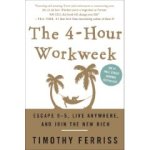 I finished up reading the “The 4-Hour Workweek”, authored by Timothy Ferriss. I don’t read too many of these self improvement type books, but I found this one to be interesting.
I finished up reading the “The 4-Hour Workweek”, authored by Timothy Ferriss. I don’t read too many of these self improvement type books, but I found this one to be interesting.
First off, the title is a bit of a misnomer, and you are likely not going to find that 4-hour workweek after reading the book. Second, at the back of the book it says “Warning: Do Not Read This Book Unless You Want to Quite Your Job”. Okay, don’t worry you can read it and not have to quit your job.
I found some of the information in the book useful and parts of it rather obvious recommendations or bold claims of “get rich quick”. But most intelligent people will be able to read between the lines and pick out the useful information.
What I liked about the book is Timothy Ferriss talks about how to streamline your business, eliminate distractions (e.g. email), automate your day to day processes, with the outcome hopefully being that you generate more revenue, but spend much less time doing it. Some rather straight forward tips that are at least worth trying out.
He also talks about taking a “mini-retirement”, a different approach than the typical work to live approach. This advice is probably more practical for someone who has a self sustaining business than someone who’s employed by another employer. But it does make you wonder why we work to live, save, and eventually retire. Why not work, save, take a mini-retirement, come back to work, save some more, and then retire?
My favorite quote from the book is “Being efficient without regard to effectiveness is the default mode of the universe”. This quote definitely rings true in some cases. Taking the time to step back and evaluate the effectiveness of what we are doing, may actually result in doing less while being more effective.
In the end, what Timothy Ferriss is suggesting we create a life that balances work and play. This is not a new concept, but his recommendations put a different spin on this topic, and are worth trying out. This book is a very easy read and worth picking up.
Enjoy the book if you choose to read.
Filed under: General | Tagged: self-improvement | Leave a comment »


